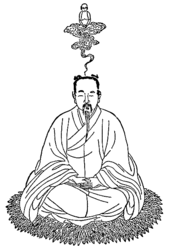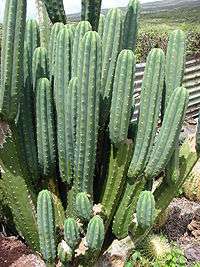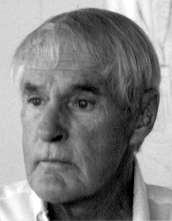Psychonautics
Psychonautics (from the Ancient Greek ψυχή psychē "soul, spirit, mind" and ναύτης naútēs "sailor, navigator" – "a sailor of the soul")[1] refers both to a methodology for describing and explaining the subjective effects of altered states of consciousness, especially an important subgroup called holotropic states, including those induced by meditation or mind-altering substances, and to a research cabal in which the researcher voluntarily immerses themselves into an altered mental state in order to explore the accompanying experiences.[2]

The term has been applied diversely, to cover all activities by which altered states are induced and utilized for spiritual purposes or the exploration of the human condition, including shamanism, lamas of the Tibetan Buddhist tradition,[3] sensory deprivation,[1] and archaic/modern drug users who use entheogenic substances in order to gain deeper insights and spiritual experiences.[4] A person who uses altered states for such exploration is known as a psychonaut.
Etymology and categorization
The term psychonautics derives from the prior term psychonaut, usually attributed to German author Ernst Jünger who used the term in describing Arthur Heffter in his 1970 essay on his own extensive drug experiences Annäherungen: Drogen und Rausch (literally: "Approaches: Drugs and Inebriation").[1][5] In this essay, Jünger draws many parallels between drug experience and physical exploration—for example, the danger of encountering hidden "reefs."
Peter J. Carroll made Psychonaut the title of a 1982 book on the experimental use of meditation, ritual and drugs in the experimental exploration of consciousness and of psychic phenomena, or "chaos magic".[6] The term's first published use in a scholarly context is attributed to ethnobotanist Jonathan Ott, in 2001.[7]
Definition and usage
Clinical psychiatrist Jan Dirk Blom describes psychonautics as denoting "the exploration of the psyche by means of techniques such as lucid dreaming, brainwave entrainment, sensory deprivation, and the use of hallucinogenics or entheogens", and a psychonaut as one who "seeks to investigate their mind using intentionally induced altered states of consciousness" for spiritual, scientific, or research purposes.[1]
Psychologist Dr. Elliot Cohen of Leeds Metropolitan University and the UK Institute of Psychosomanautics defines psychonautics as "the means to study and explore consciousness (including the unconscious) and altered states of consciousness; it rests on the realization that to study consciousness is to transform it." He associates it with a long tradition of historical cultures worldwide.[8] Leeds Metropolitan University is currently the only university in the UK to offer a module in Psychonautics.
American Buddhist writer Robert Thurman depicts the Tibetan Buddhist master as a psychonaut, stating that "Tibetan lamas could be called psychonauts, since they journey across the frontiers of death into the in-between realm."[3]
Categorization
The aims and methods of psychonautics, when state-altering substances are involved, is commonly distinguished from recreational drug use by research sources.[1] Psychonautics as a means of exploration need not involve drugs, and may take place in a religious context with an established history. Cohen considers psychonautics closer in association to wisdom traditions and other transpersonal and integral movements.[8]
However, there is considerable overlap with modern drug use and due to its modern close association with psychedelics and other drugs, it is also studied in the context of drug abuse from a perspective of addiction,[2] the drug abuse market and online psychology,[9] and studies into existing and emerging drugs within toxicology.[4]
Methods

- Hallucinogens, [1] oneirogens, and especially psychedelics such as peyote, psilocybin mushrooms, LSD and DMT, but also dissociatives and atypical psychedelics such as ketamine, dextromethorphan, Tabernanthe iboga, Amanita muscaria and Salvia divinorum
- Icaros, which are the songs (i.e. something verbal that is ordinarily perceived as an auditory sensation) the Ayahuasceros sing to induce pictorial representations, rich tapestries of colors and patterns that are visually seen by the listener. (See: synesthesia) The ayahuasca ingredient, harmine, was once known as telepathine because of this group-facilitated activity of singing icaros and the shared perception it cultivates. A shaman who is one of the Ayahuascero people is expected to memorize as many icaros as they can.
- Disruption of psychological and physiological processes required for usual mental states - sleep deprivation, fasting, sensory deprivation,[1] oxygen deprivation/smoke inhalation, holotropic breathwork
- Ritual, both as a means of inducing an altered state, and also for practical purposes of grounding and of obtaining suitable focus and intention
- Dreaming, in particular lucid dreaming[1] in which the person retains a degree of volition and awareness, and dream journals
- Hypnosis[1]
- Meditation[1]
- Meditative or trance inducing dance, like Sufi whirling can also be used to induce altered state of consciousness
- Prayer[1]
- Biofeedback and other devices that change neural activity in the brain (brainwave entrainment)[1] by means of light, sound, or electrical impulses, including: mind machines, dreamachines, binaural beats, and cranial electrotherapy stimulation
- Guided Imagery and Music (GIM) refers to all forms of music-imaging in an expanded state of consciousness, including not only the specific individual and group forms that music therapist and researcher Helen Bonny developed, but also all variations and modifications in those forms created by her followers.
These may be used in combination; for example, traditions such as shamanism may combine ritual, fasting, and hallucinogenic substances.
Works and notable figures

One of the best known psychonautical works is Aldous Huxley's The Doors of Perception.[11][12][13][14] In addition to Ernst Jünger, who coined the term, the American physician, neuroscientist, psychoanalyst, philosopher, writer and inventor John C. Lilly is another well-known psychonaut.[15] Lilly was interested in the nature of consciousness and, amongst other techniques, he used isolation tanks in his research.[16]
Philosophical- and Science-fiction author Philip K. Dick has also been described as a psychonaut for several of his works such as The Three Stigmata of Palmer Eldritch.[12] Another influential psychonaut is the psychologist and writer Timothy Leary.[13] Leary is known for controversial talks and research on the subject; he wrote several books including The Psychedelic Experience. Another widely known psychonaut is the American philosopher, ethnobotanist, lecturer, and author Terence McKenna.[17][18] McKenna spoke and wrote about subjects including psychedelic drugs, plant-based entheogens, shamanism, metaphysics, alchemy, language, culture, technology, and the theoretical origins of human consciousness.
See also
- Astral projection
- Drug culture
- Mind at Large
- Oneironautics
- Responsible drug use
- Self-experimentation
References
- Blom, Jan Dirk (2009). A Dictionary of Hallucinations. Springer. p. 434. ISBN 978-1-4419-1222-0. Retrieved 5 March 2010.
- Newcombe, Russell (2008). "Ketamine Case Study: The Phenomenology of a Ketamine Experience". Addiction Research & Theory. 16 (3): 209–215. doi:10.1080/16066350801983707. Retrieved 5 March 2010.
- As noted by Flores, Ralph (2008). Buddhist scriptures as literature: sacred rhetoric and the uses of theory. ISBN 978-0-7914-7339-9. Retrieved 5 March 2010.
- van Riel (2007). "New Drugs of Abuse". Clinical Toxicology. 45 (4): 372–3. doi:10.1080/15563650701284894. Retrieved 5 March 2010.
- Jünger. "Psychonauten". Annaherungen: Drogen und Rausch. p. 430. Cited in Taylor; et al. (2005). The Encyclopedia of Religion and Nature. Thoemmes Continuum. p. 1312. Retrieved 5 March 2010.
- Carroll, Peter J. Liber Null. (1978) and Psychonaut. (1982) (published in one volume in 1987). ISBN 0-87728-639-6.
- Ott, Jonathan (2001). "Pharmanopo-Psychonautics: Human Intranasal, Sublingual, Intrarectal, Pulmonary and Oral Pharmacology of Bufotenine". Journal of Psychoactive Drugs. 33 (3): 273–282. doi:10.1080/02791072.2001.10400574. PMID 11718320. Retrieved 5 March 2010. Cited by Blom, Jan Dirk (2009). A Dictionary of Hallucinations. Springer. p. 434. ISBN 978-1-4419-1222-0. Retrieved 5 March 2010.
- UK Institute of Psychonautics and Somanautics page Archived 10 November 2010 at the Wayback Machine at his "Academy for Transpersonal Studies". Archived from the original on 23 September 2010. Retrieved 10 March 2010.
- Schifano, Fabrizio; Leoni, Mauro; Martinotti, Giovanni; Rawaf, Salman; Rovetto, Francesco (August 2003). "Importance of Cyberspace for the Assessment of the Drug Abuse Market: Preliminary Results from the Psychonaut 2002 Project". CyberPsychology & Behavior. 6 (4): 405–410. doi:10.1089/109493103322278790. Retrieved 5 March 2010.
- Bigwood, Jeremy; Stafford, Peter J. (1992). Psychedelics encyclopedia. Berkeley, CA: Ronin Pub. pp. 118–9. ISBN 0-914171-51-8.
- Dunne, Carey (30 July 2013). "See The Contest-Winning Cover For "Brave New World"". Retrieved 25 May 2015.
- Doyle, Richard M. (2011). Darwin's Pharmacy: Sex, Plants, and the Evolution of the Noösphere. University of Washington Press. ISBN 978-0295990958.
- Carpenter, Dan (2006). A Psychonaut's Guide to the Invisible Landscape: The Topography of the Psychedelic Experience. Park Street Press. ISBN 978-1594770906.
- Jordison, Sam (26 January 2012). "The Doors of Perception: What did Huxley see in mescaline?". The Guardian. Retrieved 25 May 2015.
- Donaldson, Brian (16 January 2015). "Comedy review: Robin Ince, Edinburgh". The Scotsman. Retrieved 25 May 2015.
- Lilly, John C. (1956). "Mental Effects of Reduction of Ordinary Levels of Physical Stimuli on Intact, Healthy Persons" (PDF). Psychiatric Research Reports. 5. pp. 1–9.
- Richards, Chris (31 March 2014). "Sturgill Simpson: A country voice of, and out of, this world". Retrieved 16 June 2015.
- Harms, Shane (28 October 2014). "Fall brings a change in the climate of consciousness". Archived from the original on 24 February 2015. Retrieved 16 June 2015.